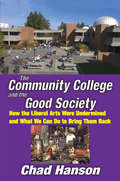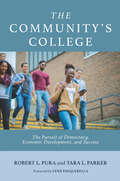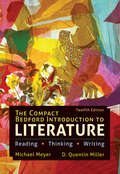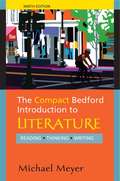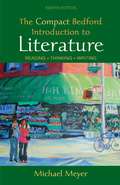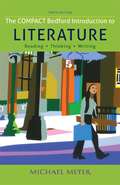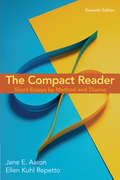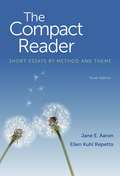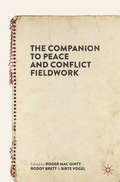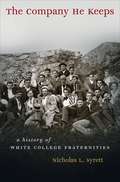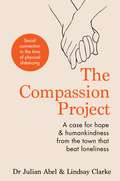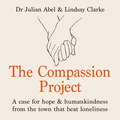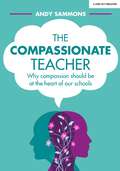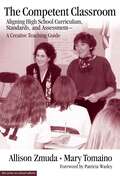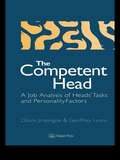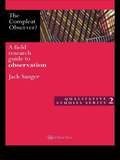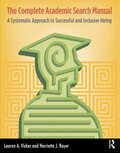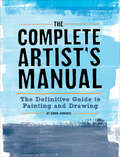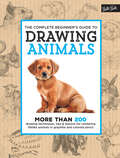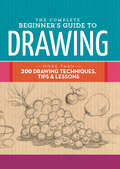- Table View
- List View
The Community College and the Good Society: How the Liberal Arts Were Undermined and What We Can Do to Bring Them Back
by Chad HansonThe community college is the largest single sector of the U.S. higher education network. As of 2005, 40 percent of newly enrolled undergraduate students attended community colleges. The American two-year school is a vast, rapidly changing, and under-studied institution. The aim of The Community College and the Good Society is tocritically analyze the internal changes and external forces that shifted the focus of the two-year college-from the liberal arts to job training. Chad Hanson raises a series of questions about what is lost or forsaken when public institutions become preoccupied with economic goals. When educational institutions turn their attention toward training workers to private-sector specifications, Hanson argues, our social and cultural lives suffer. He describes the "the learning college movement," an ideological framework that justifies the current emphasis on vocational training. In addition, he explores the implications of competency-based education, a philosophy and method for creating curriculum with strong support among administrators and boards of trustees. For more than four decades, a steady stream of commentary aimed at understanding the two-year school made its way into the literature on higher education. In this work, Hanson provides an alternative view of the community college. He offers suggestions for new teaching strategies, curriculum, and organizational structure. These changes will encourage the potential for the two-year college to flourish as an institution that provides a permanent place for the arts and sciences.
The Community's College: The Pursuit of Democracy, Economic Development, and Success
by Tara L. Parker Robert L. PuraCo-published with An Agenda for Leaders / A Text for Leadership CoursesWhile community colleges promote American ideals of democracy, opportunity, and social mobility; they provide a vital, accessible, and affordable education for nearly 12 million first-generation, economically-disadvantaged, and minoritized students; are engines of local workforce and economic development; and enroll nearly half of all students who go on to complete a four-year degree; they remain the least resourced and the least funded institutions in the United States.Offering the insights of the former president of Greenfield Community College—located in Massachusetts’s poorest rural county—who was a national leader in community college and higher education organizations as well as closely involved with local businesses and organizations; and commentary and background data provided by Professor of Higher Education and Chair of the Department of Leadership in Education at the University of Massachusetts Boston, this book addresses the challenges that community colleges face as they strive to achieve their complex missions in a changing world.By providing vivid accounts of the diversity of students that community colleges serve, the complexity of their missions—from dual enrollment with high schools, to vocational training, adult education, and transfer to four-year colleges—and the role they play in supporting and responding to the needs of local business, as well in regional economic development, the authors make the case for increased investment, while at the same time making apparent to all stakeholders—from policy makers and trustees to college leaders, faculty and staff—how they can contribute to the vital development of human capacities.Community colleges are open-access, train nearly 80% of all first responders, graduate more than half of new nurses and health-care workers, and have a history of nimbleness and responsiveness to community needs, and can play a vital role in training for tomorrow’s jobs, over 60% of which will, in the next decade, require some college education. The first four chapters set the scene, demonstrating the key foundational linkage between education, community, and democracy, presenting a history of the community college movement, illustrating what’s involved in building strong and reciprocal community relationships, and covering a whole panoply of leadership issues such as governance, institutional culture, facilities planning, resource development, accreditation, and crisis management.The second part of the book presents Bob Pura’s accounts of his visits to five community colleges, each representing different geographic regions, institutional size, urban and rural locations, and how they respond to the varied racial and ethnic populations from they draw their students and establish themselves as anchors in their communities.As well as offering an important message to state and federal policy makers, this book serves as a roadmap for aspiring leaders of community colleges as well as a text for leadership and higher education courses. College leaders may find it useful for internal training and learning community groups.
The Compact Bedford Introduction to Literature: Reading, Thinking, And Writing
by Michael Meyer D. MillerPACKAGE THIS TITLE WITH OUR 2016 MLA SUPPLEMENT, Documenting Sources in MLA Style (package ISBN-13: 9781319086251). Get the most recent updates on MLA citation in a convenient, 40-page resource based on The MLA Handbook, 8th Edition, with plenty of models. Browse our catalog or contact your representative for a full listing of updated titles and packages, or to request a custom ISBN. The Bedford Introduction to Literature is a best-seller for a reason: It brings literature to life for students, helping to make them lifelong readers and better writers. Classic works drawn from many periods and cultures--by the authors you love to teach--appear alongside a strong selection of today's notable writers. There is ample support for students, with a dozen chapters of critical reading and writing support, helpful sample close readings, writing assignments, and student papers. And, because everyone teaches and learns a little differently, there are lots of options for working with the literature, including case studies on individual works and themes that everyone can relate to. In-depth chapters on major authors like Flannery O'Connor and Robert Frost take students deeper into their work, and chapters on the fiction of Dagoberto Gilb and the poetry of Billy Collins and Julia Alvarez--created in collaboration with the authors themselves--are one more way that the anthology showcases literature as a living, changing art form. Featuring a new thematic case study on war fiction and a new cultural case study on John Patrick Shanley's celebrated play Doubt--a proven success in the classroom--the eleventh edition helps students draw lasting connections between the literature they read and the world around them
The Compact Bedford Introduction to Literature: Reading, Thinking, Writing
by Michael MeyerThe Compact Bedford Introduction to Literature is a best-seller for a reason: it brings literature to life for students -- helping to make them lifelong readers and better writers. Classic works from many periods and cultures exist alongside a diverse representation of today's authors. Support for students includes a dozen chapters of critical reading and writing, with plenty of sample close readings, writing assignments, and student papers. And, because everyone teaches a little differently, there are lots of options for working with the literature, including in-depth chapters on major authors and case studies on individual works and themes that everyone can relate to. New to this edition are casebooks on short fiction and the natural world and a chapter created with Billy Collins. This anthology is now available with video! Learn more about VideoCentral for Literature.
The Compact Bedford Introduction to Literature: Reading, Thinking, Writing (8th Edition)
by Michael MeyerThe Compact Bedford Introduction to Literature is designed to bring literature to life -- and to make students lifelong readers. As an instructor of literature and writing, editor Michael Meyer understands that a particular challenge in today's classroom is that students may not see literature as relevant to their lives. They may have difficulty reading it critically and lack confidence in their writing skills. With these factors in mind, Meyer has put together a lively collection of literature drawn from many periods, cultures, and voices, with an excellent representation of contemporary authors, women authors, and authors of color. These works are presented with more than a dozen chapters of critical reading and writing support, and a generous helping of sample close readings, writing assignments, and student papers. And, because everyone teaches a little differently, the book offers more options for working with the literature than any comparable anthology -- including in-depth chapters on major authors and case studies on individual works and universal themes.
The Compact Bedford Introduction to Literature: Reading, Thinking, and Writing (Tenth Edition)
by Michael MeyerLike its predecessors, the tenth edition of The Compact Bedford Introduction to Literature assumes that reading and understanding literature offers a valuable means of apprehending life in its richness and diversity. This book also reflects the hope that its selections will inspire students to become lifelong readers of imaginative literature, as well as more thoughtful and skillful writers.
The Compact Reader: Short Essays By Method And Theme (Eleventh Edition)
by Jane E. Aaron Ellen Kuhl RepettoThe Compact Reader offers an innovative dual organization; it can be taught rhetorically or thematically. Each rhetorical method is paired with an engaging thematic topic so that readings display the full range and flexibility of writing in each mode. Selections average just two or three pages in length, so that students can read them quickly, analyze them thoroughly, and emulate them successfully. A brief guide to reading and writing, detailed chapter introductions, and two final chapters on working with sources serve as a mini-rhetoric, providing students with the support they need. For instructors who want a concise, affordable, effective resource for teaching the connection between form and content, The Compact Reader is the perfect choice.
The Compact Reader: Short Essays by Method and Theme (Tenth Edition)
by Jane E. Aaron Ellen Kuhl RepettoThe Compact Reader seamlessly combines four texts--a short-essay reader, a rhetorical reader, a thematic reader, and a brief rhetoric--into one slim volume containing three dozen engaging, high-quality essays.
The Companion to Peace and Conflict Fieldwork
by Roddy Brett Roger Mac Ginty Birte VogelThis unique companion is a much-needed guide for those who are embarking on field research in conflict-affected countries. In a break with academic tradition, the chapters are mainly written in the first person and contain personal accounts of the ethical and practical challenges of fieldwork. In the book, over thirty scholars reflect on the complexity of dealing with human subjects in conflict-affected contexts. This indispensable book provides insider knowledge and gives confidence to researchers - both those at the very start of their careers or during their studies, and experienced researchers who want to consider positionality, responsibility and the moral obligation of the researcher in new ways. Essential reading for students and scholars embarking upon fieldwork in International Relations, Politics, Sociology, Political Geography and Anthropology.
The Company He Keeps
by Nicholas L. SyrettTracing the full history of traditionally white college fraternities in America from their days in antebellum all-male schools to the sprawling modern-day college campus, Nicholas Syrett reveals how fraternity brothers have defined masculinity over the course of their 180-year history. Based on extensive research at twelve different schools and analyzing at least twenty national fraternities, The Company He Keeps explores many factors--such as class, religiosity, race, sexuality, athleticism, intelligence, and recklessness--that have contributed to particular versions of fraternal masculinity at different times. Syrett demonstrates the ways that fraternity brothers' masculinity has had consequences for other students on campus as well, emphasizing the exclusion of different groups of classmates and the sexual exploitation of female college students.
The Comparative Politics of Education
by Moe Terry M. Susanne WiborgPublic education is critically important to the human capital, social well-being, and economic prosperity of nations. It is also an intensely political realm of public policy that is heavily shaped by power and special interests. Yet political scientists rarely study education, and education researchers rarely study politics. This volume attempts to change that by promoting the development of a coherent, thriving field on the comparative politics of education. As an opening wedge, the authors carry out an 11-nation comparative study of the political role of teachers unions, showing that as education systems everywhere became institutionalized, teachers unions pursued their interests by becoming well-organized, politically active, highly influential - and during the modern era, the main opponents of neoliberal reform. Across diverse nations, the commonalities are striking. The challenge going forward is to expand on this study's scope, theory, and evidence to bring education into the heart of comparative politics.
The Compassion Project: A case for hope and humankindness from the town that beat loneliness
by Lindsay Clarke Julian Abel'A wonderful book' - Dr. Rangan Chatterjee'Highly convincing' - Daily Express'Pioneering' - The Telegraph'The strength of the book lies in its description of how community life can have a transformative effect on individuals' - British Journal of General PracticeAcross the country, general hospital admissions are on the rise. But in a small town in rural England, thanks to the simple introduction of kindness and compassion, that trend has been reversed. And what this town achieved, we can all adopt in our own lives to powerful effect. Through daily mindful acts of care we are capable of changing things for the better, both inside ourselves and for the world around us. Frome in Somerset isn't special. It could be any town; it could be your town. And yet the people who live there have a story to tell about the simple, ground-shaking power of compassion. If it came in tablet form, it would be hailed as a wonder of modern medicine. By contrast, it's entirely free but offers heartening evidence that when human beings make time for each other, the beneficial effects go far beyond the reach of naïve optimism.'A culture in which compassion is a prevailing value allows individuals to flourish and bring their talents and gifts to the communities in which they live. Unanticipated possibilities emerge, presenting fresh ways of addressing what previously appeared to be insoluble problems. Hearts are lifted. The case for hope is more strongly made. And as the people who work in this way begin to change the world immediately around them, so too, the wider world beyond begins to change.' Dr Julian Abel & Lindsay Clarke
The Compassion Project: A case for hope and humankindness from the town that beat loneliness
by Lindsay Clarke Julian Abel'A wonderful book' - Dr. Rangan Chatterjee'Highly convincing' - Daily Express'Pioneering' -The Telegraph'The strength of the book lies in its description of how community life can have a transformative effect on individuals' - British Journal of General PracticeAcross the country, general hospital admissions are on the rise. But in a small town in rural England, thanks to the simple introduction of kindness and compassion, that trend has been reversed. And what this town achieved, we can all adopt in our own lives to powerful effect. Through daily mindful acts of care we are capable of changing things for the better, both inside ourselves and for the world around us. Frome in Somerset isn't special. It could be any town; it could be your town. And yet the people who live there have a story to tell about the simple, ground-shaking power of compassion. If it came in tablet form, it would be hailed as a wonder of modern medicine. By contrast, it's entirely free but offers heartening evidence that when human beings make time for each other, the beneficial effects go far beyond the reach of naïve optimism.'A culture in which compassion is a prevailing value allows individuals to flourish and bring their talents and gifts to the communities in which they live. Unanticipated possibilities emerge, presenting fresh ways of addressing what previously appeared to be insoluble problems. Hearts are lifted. The case for hope is more strongly made. And as the people who work in this way begin to change the world immediately around them, so too, the wider world beyond begins to change.' Dr Julian Abel & Lindsay Clarke
The Compassion Project: A case for hope and humankindness from the town that beat loneliness
by Lindsay Clarke Julian Abel'It could... be one of the most dramatic medical breakthroughs of recent decades. It could transform treatment regimes, save lives, and save health services a fortune. Is it a drug? A device? A surgical procedure? No, it's a newfangled intervention called community.' George Monbiot, The GuardianFrome in Somerset has seen a dramatic fall in emergency hospital admissions since it began a collective project to combat isolation. While emergency admissions to hospitals across Somerset have increased by 29%, incurring a 21% increase in costs, Frome has seen admissions fall by 17%, with a 21% reduction in costs.Society has developed in such a way to facilitate a drastic malnourishment of community, connection and compassion. This book sets out the case for the effective restoration of the active power of compassion as a widely available, fundamental force for good in all aspects of human life. In the process, it draws attention to research which demonstrates that an innate capacity and need for compassionate behaviour is closely woven into the fabric of our bodies.But this is also a book with stories to tell - the stories of how, by harnessing the power of compassion in the lives of real men and women, the small English town of Frome has opened up a new approach to the practice of medicine which has improved individual health and welfare while at the same time enhancing the vitality of the whole community. The effects of this approach have proved so beneficial that it has attracted international attention and is now transforming perspectives on issues of healthcare and social welfare across the world.(p) 2020 Octopus Publishing Group
The Compassionate Classroom: Relationship Based Teaching and Learning
by Sura Hart Victoria Kindle HodsonThis is a long awaited how-to guide for educators who care about creating a safe, productive learning environment. With 45 years combined teaching experience, Sura Hart and Victoria Kindle Hodson merge recent discoveries in brain research with the proven skills of Non-violent Communication and come to a bold conclusion -- when compassion thrives, so does learning. Learn powerful skills to create an emotionally safe learning environment where academic excellence thrives. Build trust, reduce conflict, improve co-operation, and maximise the potential of each student as you create relationship-centred classrooms. This how-to guide is perfect for any educator, home school parent, administrator or mentor. Customisable exercises, activities, charts and cut-outs make it easy for educators to create lesson plans for a day, a week or an entire school year. This is the first complete curriculum for teaching NVC to elementary age students.
The Compassionate Teacher: Why compassion should be at the heart of our schools
by Andy SammonsAsk any teacher why they went into teaching, and they'll invariably refer to students or their subject. Yet, modern educators are faced with a dilemma: the industry judges us primarily on outcomes, offering the justification that grades improve life chances. Grades improve life chances as much as money buys happiness: it's no more than a prop or a poor substitute. Unless the profession starts to get to the heart of its reason for being, we might as well all pack up and go home. Education has a problem with its `why,' and unless it starts to encourage and insist its stakeholders start to improve their understanding of why compassion and relationships should be at the heart of everything we do, the same familiar cyclical mistakes will continue to be made, and all of those lovely things that we say we do in modern education such as improving life chances, creating citizens of the future and shaping young minds will be no more than an accidental and indirect by-product of time spent in our educational establishments.
The Compassionate Teacher: Why compassion should be at the heart of our schools
by Andy SammonsAsk any teacher why they went into teaching, and they'll invariably refer to students or their subject. Yet, modern educators are faced with a dilemma: the industry judges us primarily on outcomes, offering the justification that grades improve life chances. Grades improve life chances as much as money buys happiness: it's no more than a prop or a poor substitute. Unless the profession starts to get to the heart of its reason for being, we might as well all pack up and go home. Education has a problem with its `why,' and unless it starts to encourage and insist its stakeholders start to improve their understanding of why compassion and relationships should be at the heart of everything we do, the same familiar cyclical mistakes will continue to be made, and all of those lovely things that we say we do in modern education such as improving life chances, creating citizens of the future and shaping young minds will be no more than an accidental and indirect by-product of time spent in our educational establishments.
The Competent Classroom: Aligning High School Curriculum, Standards, and Assessment--A Creative Teaching Guide
by Allison Zmuda Mary TomainoWritten by teachers for teachers, this enlightening book describes the cross-disciplinary journey of two high school teachers trying to align curriculum, assessment, and performance standards in their classrooms. With a focus on the importance of constantly inspiring students, the authors troubleshoot issues surrounding content standards, instructional objectives, and the aims of curriculum. This user-friendly guide: Helps readers consider the main concepts surrounding creative teaching and ways of helping students take ownership of their learning Provides insight into what it takes for teachers to learn about, work with, and benefit from standards work Gives teachers practical advice for achieving greater success in the classroom Targets the connections between essential questions, content, assessments, and performance standards This creative and informative guide will inspire any educator who wrestles with how to make classroom learning meaningful to students and who cares about academic achievement and success.
The Competent Head: A Job Analysis Of Headteachers' Tasks And Personality Factors
by Dilum Jirasinghe Geoffrey LyonsFirst published in 1996. Routledge is an imprint of Taylor & Francis, an informa company.
The Compleat Academic: A Practical Guide for the Beginning Social Scientist
by Mark P. Zanna John M. DarleyThis volume is a collection of information about the concerns and problems of the beginning social scientist in the academic and nonacademic world. Covering topics from the senior graduate student's job search to the assistant professor's research and teaching experiences, this book serves as an official introduction to the "rules of the academic game".
The Compleat Observer?: A Field Research Guide to Observation
by Jack SangerCombining anecdotal accounts, inter-professional experiences, critical debate and practical pointers to being a good observer, this book explores issues surrounding observation in social science-orientated research.
The Complete Academic Search Manual: A Systematic Approach to Successful and Inclusive Hiring
by Lauren A. Vicker Harriette J. RoyerCovers searches for all faculty, staff, and administrative positions Emphasizes aligning hires to departmental and institutional goals Describes proven practices for successful outcomes Successful academic searches, where high caliber college faculty and administrators are recruited and retained, are critical to the vitality and sustainability of every institution. In higher education many faculty and administrators are thrust into the role of academic search with little preparation other than their own experience of being interviewed. Typically search committees also have to manage the process in the context of already heavy workloads. This manual provides faculty members, department heads, chairs, deans, and members of search committees with a straightforward ten-step process, using proven strategies and systematic planning, designed to facilitate group dynamics while members seek out and identify high caliber candidates and reach consensus on the best one for the institution.This book concisely lays out everything committee members need to know, replete with real life examples from diverse institutions, sample forms, timelines, and checklists. The process begins with the composition of the committee, understanding its charge, and the responsibilities of the chair and its members. It then leads the committee through the steps of drawing up the position description using input from all stakeholders, publicizing the position, evaluating resumes, planning and conducting interviews, narrowing the pool, to the final selection and negotiation processes. Throughout, the authors attend to issues of diversity and inclusion, aligning the hire with institutional goals, and avoiding legal pitfalls. Equally importantly, they set out a framework for welcoming, acclimating, and retaining new hires to ensure the return on the institution’s substantial investment of time and expense to recruit them.
The Complete Artist's Manual: The Definitive Guide to Painting and Drawing
by Simon Jennings&“Comprehensive and substantial . . . This practical text is accessible to artists of all skill levels.&” —Booklist The hands-on, user-friendly painting and drawing guidance that made The Artist&’s Manual and The New Artist&’s Manual beloved classics now returns in a refreshed design and compact new package. With the same breadth of content as the originals, this updated version is packed with easy to follow instructions, including comprehensive information about all varieties of materials and tools, along with hundreds of critical techniques for mastering composition, color, line, tone, and more. Copiously illustrated with 1,300 color photos and examples from working artists, this new edition is the definitive guide for artists of every skill level looking to begin, develop, and perfect their skills. The Complete Artist&’s Manual is today&’s essential studio companion.
The Complete Beginner's Guide to Drawing Animals: More Than 200 Drawing Techniques, Tips & Lessons for Rendering Lifelike Animals in Graphite and Colored Pencil
by Walter Foster Creative TeamLearn to create pet portraits, wildlife scenes, and cartoon creatures with the helpful tips and step-by-step lessons in this comprehensive resource.The Complete Beginner’s Guide to Drawing Animals starts with a thorough introduction to the essential tools and materials artists need to get started, including different types of pencils, sketchbooks, papers, erasers, and more. This helpful resource features dozens of comprehensive drawing lessons designed to teach aspiring artists how to draw a variety of animals, from lifelike pet portraits to zoo and safari animals. Artists will discover the fundamentals of drawing and techniques for rendering realistic animal textures, such as fur, feathers, whiskers, manes, and hair; creating volume; shading; developing a composition; and mastering perspective, all with the goal of drawing dozens of lifelike animals in graphite and colored pencil.
The Complete Beginner's Guide to Drawing: More Than 200 Drawing Techniques, Tips & Lessons
by Walter Foster Creative TeamPractice drawing a variety of subjects and build or hone your artistic skills with this helpful guide featuring over two hundred drawing techniques, tips and tricks.This comprehensive drawing guide covers a vast array of subjects, from landscapes, still lifes, and flowers to animals, portraits, and the human figure. Begin with a thorough introduction to the essential tools and materials you need to get started, including different types of pencils, sketchbooks, papers, and other tools. Then learn the fundamentals of drawing, as well as a variety of drawing techniques, including rendering realistic textures, creating volume, and capturing perspective. A series of easy-to-follow, step-by-step projects cover a variety of techniques, including:Developing formRendering textureDepth and distanceForeshorteningValues and shadingPerspectiveBalance and compositionCapturing realism and likenessDepicting figures in actionWith helpful tips and straightforward step-by-step lessons, The Complete Beginner’s Guide to Drawing is the perfect resource for beginning artists who want to improve their drawing skills.
